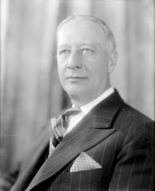U.S. presidential election, 1928
|
|
|||||||||||||||||||||||||||||
|---|---|---|---|---|---|---|---|---|---|---|---|---|---|---|---|---|---|---|---|---|---|---|---|---|---|---|---|---|---|
|
|||||||||||||||||||||||||||||
|
531 electoral votes of the Electoral College 266 electoral votes needed to win |
|||||||||||||||||||||||||||||
| Turnout | 56.9% |
||||||||||||||||||||||||||||
|
|||||||||||||||||||||||||||||
|
Presidential election results map. Red denotes states won by Hoover/Curtis, blue denotes those won by Smith/Robinson. Numbers indicate the number of electoral votes allotted to each state.
|
|||||||||||||||||||||||||||||
|
|||||||||||||||||||||||||||||
The United States presidential election of 1928 was the 36th quadrennial presidential election, held on Tuesday, November 6, 1928. Secretary of Commerce Herbert Hoover was nominated as the Republican candidate, as incumbent President Calvin Coolidge chose not to run for a second full term. New York Governor Al Smith was the Democratic nominee. Hoover and Smith had been widely known as potential presidential candidates long before the campaign of 1928, and both were generally regarded as outstanding leaders. Each candidate was a newcomer to the presidential race and presented in his person and record an appeal of unknown potency to the electorate. Each candidate also faced serious discontent within his party membership, and neither possessed the wholehearted support of his party organization.
In the end, the Republicans were identified with the booming economy of the 1920s, whereas Smith, a Roman Catholic, suffered politically from anti-Catholic prejudice, his anti-prohibitionist stance, and his association with the legacy of corruption of Tammany Hall. The result was a third consecutive Republican landslide, a result that would only be repeated in 1988. Hoover narrowly failed to carry a majority of former Confederate states, but nonetheless made substantial inroads in the traditionally Democratic Solid South.
...
Wikipedia




